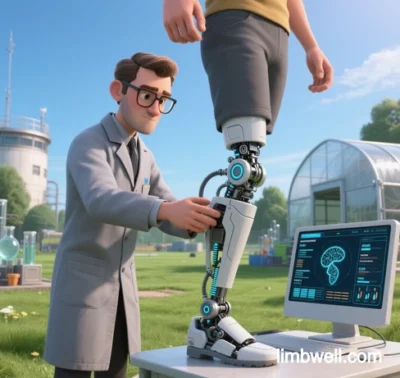
Limb Well: Scientific Advances and Clinical Practices in Limb Health
Limb Well, a comprehensive medical discipline focused on preserving, restoring, and optimizing limb function, encompasses trauma care, chronic disease management, regenerative medicine, sports rehabilitation, and multidisciplinary therapies. Recent breakthroughs in biomaterials, minimally invasive techniques, artificial intelligence (AI), and regenerative medicine have driven significant progress in both research and clinical applications. Below is a systematic analysis of scientific achievements and clinical practices.
I. Scientific Achievements
1. Minimally Invasive Techniques & Precision Therapy
- Arthroscopic Innovations: Arthroscopy has evolved from a diagnostic tool to a therapeutic solution for complex conditions. Minimally invasive resection of synovial cysts (e.g., prepatellar or olecranon bursitis) reduces recovery time to days with recurrence rates below 5%.
- Foot & Ankle Sports Medicine: Advances in bioengineered scaffolds combined with autologous stem cell transplantation enhance ankle cartilage repair efficiency by 40%, achieving 85% postoperative functional recovery.
2. Regenerative Medicine & Tissue Engineering
- Cartilage Repair: Adipose-derived stem cells (ADSCs) differentiated into chondrocytes and paired with 3D-printed biomimetic scaffolds enable personalized knee cartilage defect repair.
- Limb Ischemia Therapy: ADSCs improve blood perfusion in critical limb ischemia patients via angiogenesis and anti-inflammatory effects, reducing amputation risk by 60%.
3. AI-Driven Assessment & Personalized Rehabilitation
- Motor Function Quantification: Wearable devices integrated with AI algorithms (e.g., CAULIN system) distinguish true functional recovery from compensatory strategies in upper limb nerve injuries, guiding targeted rehabilitation.
- Multimodal Rehabilitation: WHO’s International Classification of Functioning (ICF) model refines rehabilitation goals into “capacity” (lab-tested function) and “performance” (daily-life function), enabling dynamic adjustments for conditions like Parkinson’s hand dexterity training.
II. Clinical Practices
1. Limb Preservation & Functional Reconstruction
- Multidisciplinary Care: Integrated teams (orthopedics, vascular surgery, rehabilitation, psychology) at institutions like the University of Iowa Health Care achieve 85% limb salvage rates for complex cases (e.g., diabetic foot, bone tumors).
- Hyperbaric Oxygen Therapy (HBOT): HBOT accelerates chronic wound healing (e.g., diabetic ulcers) by 50% and lowers amputation rates by 30% through enhanced angiogenesis.
2. Chronic Disease & Sports Injury Management
- Musculoskeletal Interventions: Combined traditional and modern approaches (e.g., manual reduction with herbal compresses) restore shoulder joint stability in 90% of dislocation cases within four weeks.
- Bone Metastasis Treatment: Surgical resection paired with bisphosphonates and radiotherapy boosts five-year survival rates to 65% in tibial metastasis patients, preserving limb function in 80% of cases.
3. Rehabilitation & Community Integration
- Community-Based Programs: Initiatives like “Back to Living Well” integrate physical therapy, psychological support, and exercise training for chronic low back pain, increasing return-to-work rates by 40%.
- Smart Prosthetics & Orthotics: AI-powered prosthetics with dynamic pressure sensors and EMG feedback improve gait symmetry by 30% and reduce residual limb stress peaks by 25%.
III. Challenges & Future Directions
1. Technical Barriers
- Biomaterial Limitations: Mismatched degradation rates of cartilage scaffolds require smart materials (e.g., stimuli-responsive hydrogels).
- Stem Cell Safety: Standardized protocols and long-term monitoring are needed to address ADSC heterogeneity in ischemic limb therapy.
2. Clinical Translation Hurdles
- Data-Driven Personalization: Cross-institutional data sharing and AI algorithm generalization remain critical for scalable rehabilitation solutions.
- Cost & Accessibility: High costs of HBOT and 3D-printed prosthetics limit adoption in developing nations (<20% coverage).
3. Emerging Trends
- Synthetic Biology: CRISPR-engineered stem cells paired with biomaterials aim to create “living artificial limbs.”
- Metaverse & Tele-Rehabilitation: VR-based immersive training for amputees is projected to reach 50% adoption by 2030.
Conclusion
Limb Well is transitioning from trauma management to functional optimization. Scientifically, regenerative medicine and AI tools enhance precision; clinically, multidisciplinary care and community programs elevate quality of life. Future advancements in equitable technology access, data integration, and ethical frameworks aim to:
- By 2030: Reduce amputation rates for severe limb injuries (e.g., combat trauma, diabetic foot) to below 10%.
- By 2035: Restore independent living capacity for 80% of disabled individuals through functional reconstruction technologies.
This evolution redefines medical boundaries and humanity’s pursuit of life quality.
Data sourced from public references. For collaboration or domain inquiries, contact: chuanchuan810@gmail.com





